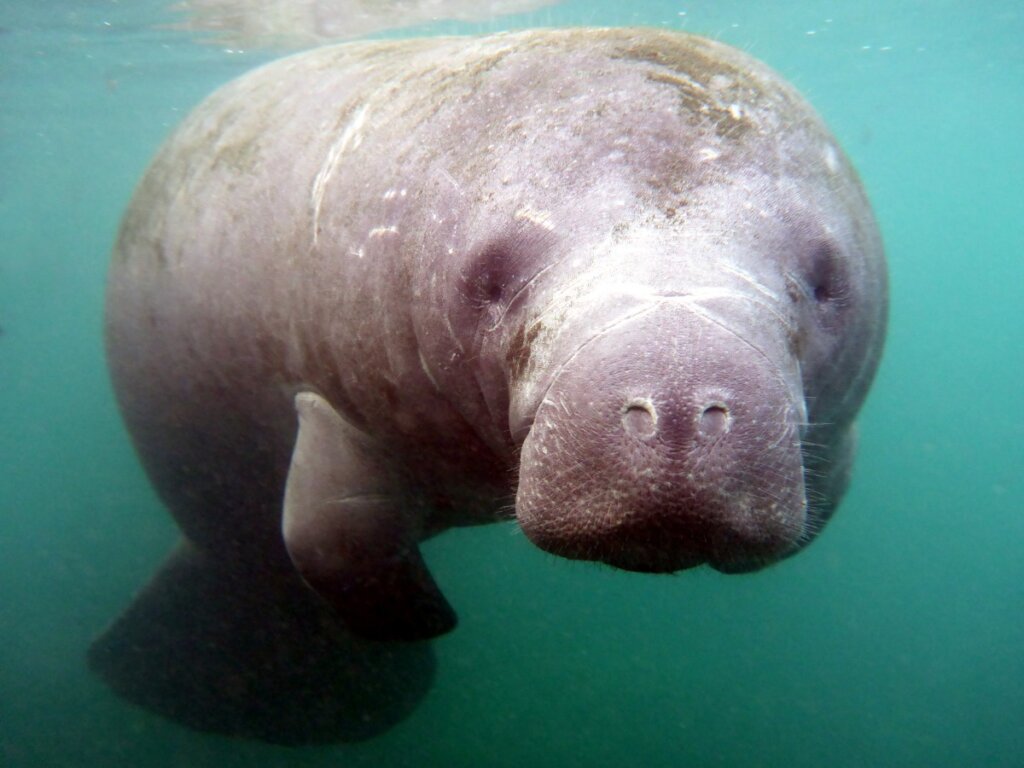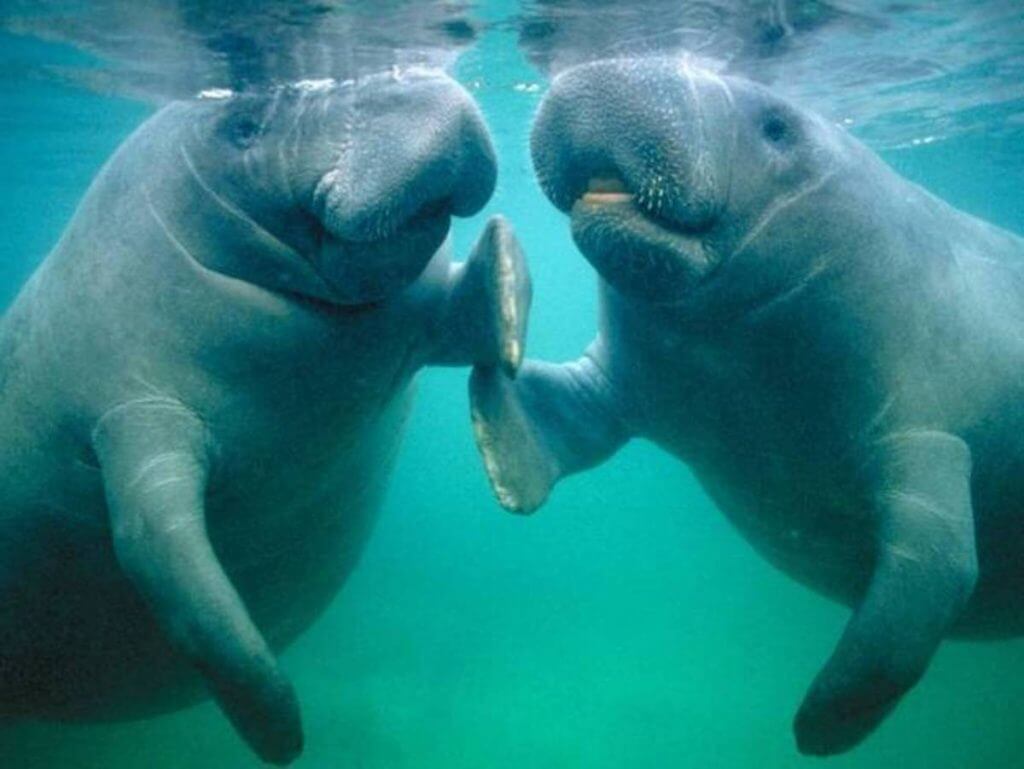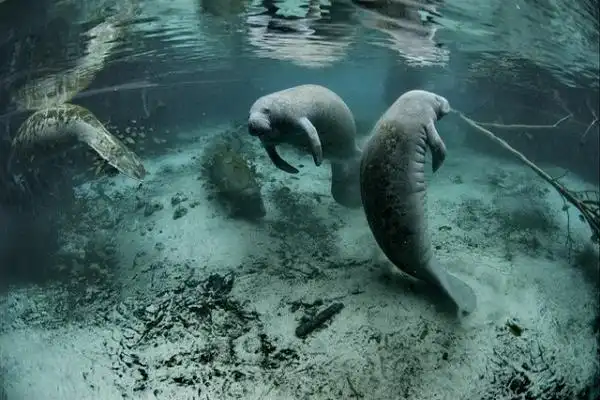7 Curiosities About Manatees

Manatees are aquatic mammals with a large population on the planet and a long history. Peaceful and large in size, these endangered giants have become a symbol of warm water adaptation. Stay with us to find out some curiosities about manatees.
These large marine mammals are generally gray in color and their bodies taper to a flat surface; they have a spoon-shaped tail and two arms called flippers. Their face has wrinkles, as well as whiskers on the snout.
Curiosities about manatees
These aquatic giants, also known as sea cows, have many characteristics that make them extraordinary animals. In the following lines, you’ll learn 7 curiosities about manatees.
1. They eat a lot of vegetables
Its diet is based entirely on vegetables such as seaweed and sea grasses. As a manatee can weigh between 300 and 500 kg (660 to 1200 pounds), it needs to eat large quantities of vegetables.
It eats up to 50 kg (110 pounds) per day and, because of this, spends most of its hours chewing its food. For this reason, it has earned the nickname of “sea cow”, as it ingests up to 10% of its body mass.
The West Indian manatee usually eats fish caught in nets, so it isn’t entirely vegetarian. As a unique physical characteristic, they have a split upper lip and each side can move independently of the other.

2. They inhabit both freshwater and saltwater ecosystems
The manatee genus consists of four species:
- Caribbean or Florida
- African
- Amazonian (inhabits the entire Amazon basin, from Peru to Venezuela).
- Dwarf manatee (the inclusion of this specimen in the manatee family is still under discussion).
All these species inhabit both freshwater and saltwater. For this purpose, they have developed a regulation system in their kidneys that allows them to control the salt levels in their bodies when they’re at sea. However, they always return to places with fresh water to hydrate themselves.
They never leave the water, not even to give birth, so they’re totally aquatic and not like seals and walruses.
For this reason, it has earned the nickname of “sea cow”, as it ingests up to 10% of its body mass.
3. It’s one country’s national symbol of the marine fauna
In 2014, the Costa Rican Congress declared the manatee the symbol of the country’s marine fauna, in order to stimulate initiatives for its conservation.
The manatee reserve in Costa Rica is located in Tortuguero National Park. Having a great variety of fauna, the manatee is vital in order to conserve the balance in its ecosystem.
4. They’re distant cousins of the elephant
Due to the similarities found between both species, studies suggest that manatees and elephants descend from the same animal.
50 million years ago (early Eocene), manatees became the branch that stayed in the water and elephants became the branch that went ashore. As a current similarity, we can comment on the gestation period, which is a very similar length in both species.
5. Like elephants, manatees replace their teeth
Manatees will constantly change teeth like elephants.
When these animals’ front teeth animals fall out, they’re replaced by back teeth. At the same time, a new row of teeth will form waiting to replace the current one. This goes on in the same way throughout their lives.
In this way, they’re similar to sharks, but sharks only replace the teeth they lose through wear or breakage. Manatees will change teeth in the same way as elephants – constantly- as their teeth change without needing to break to do so.
6. At first it was thought that they were obese mermaids

Due to the fatigue of sea voyages at the time of the discovery of America, many sailors (including Christopher Columbus himself) claimed to have sighted mermaids. These mermaids were horrendous, according to some travel journals. However, we now know what they actually saw were manatees. And this is why another term used to name them is “sirenios“, from the Greek “siren”.
7. It has only one predator: man
Man has hunted the manatee for centuries, to take advantage of its meat and fat. Apart from man, the manatee has no other predator that feeds on it. These days, because certain species are already threatened with extinction, they’re protected. Protection includes avoiding toxic waste in the areas where they feed.
With a natural habitat in retreat due to human advancement, the survival of the species is reduced to the conservation of natural reserves where colonies can live safely. The populations grow slowly, as they reproduce every 3 years and their gestation period lasts a whole year. As a result, births are few and far between, and it’s difficult to stabilize the population if a poacher causes casualties .
We hope you enjoyed our curiosities about manatees!
All cited sources were thoroughly reviewed by our team to ensure their quality, reliability, currency, and validity. The bibliography of this article was considered reliable and of academic or scientific accuracy.
- INBio – Panterpe insignis. (s. f.). INBio. Recuperado 11 de octubre de 2021, de http://www.crbio.cr:8080/neoportal-web/species/Panterpe%20insignis
- Información Sobre los Manatíes – Save the Manatee Club [Internet]. Save the Manatee Club. [cited 25 February 2020]. Available from: https://www.savethemanatee.org/manatees/education-materials/informacion-sobre-los-manaties/
- Pérez Más E. Mamíferos. [Barcelona]: Bruguera; 1978.